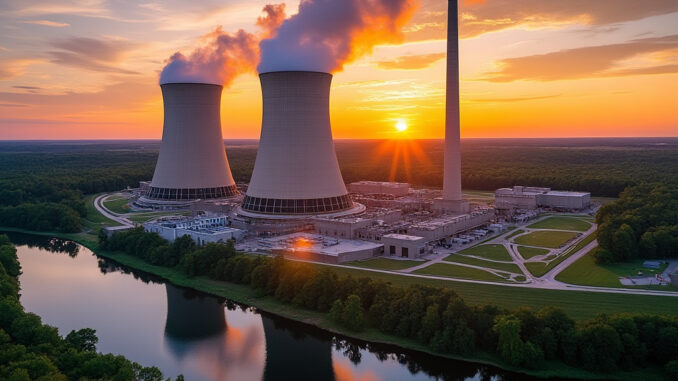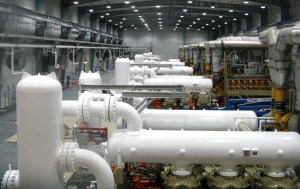
- The US government is supporting the reopening of the Palisades nuclear power plant, the first such effort in the country’s history.
- This reflects a shift in US energy policy towards nuclear power as a clean energy source to meet growing clean energy demand.
- The Palisades reopening could pave the way for the revival of other closed nuclear plants and the development of small modular reactors.
The U.S. Palisades Power Plant could become the first nuclear plant to reopen in the U.S. after shutting down, potentially signaling a new era for U.S. nuclear power. As the U.S. government supports a new wave of nuclear reactor development, in support of a green transition, the reopening of existing plants could help the country develop its nuclear power capacity more rapidly. The Biden administration has provided financial support to several struggling nuclear plants to help them keep their doors open, and the Inflation Reduction Act (IRA) and other recent policies are encouraging the development of new nuclear operations. Pressure from the government to decarbonize the economy and financial incentives for companies pursuing green energy could also support alternative nuclear developments, such as the restoration and reopening of old reactors.
The Palisades Power Plant in Covert, Michigan, shut its doors after 40 years of operation in May 2022. This was largely due to the increase in production of cheap, abundant natural gas encouraging a shift away from nuclear energy. It was not the only power plant to shut down, with several prominent plants failing over the previous decade. The U.S. has the largest nuclear power plant fleet in the world, with 93 reactors capable of generating around 95,522 MW of electricity. Nuclear power has contributed around 20 percent of the country’s electricity annually for the last 30-plus years. However, the huge expense of keeping nuclear plants open, as well as concerns around safety and nuclear waste, have resulted in the closure of several plants in recent years. Between 2012 and 2022, 12 U.S. nuclear plants, with a combined electric generating capacity of 9,436 MW, closed their doors. Some plants due for closure have managed to survive, thanks to state and federal intervention, but companies could not afford to keep many of the others running.
However, increased global pressure to undergo a green transition, and the introduction of the IRA, have encouraged companies across the U.S. to develop new nuclear energy operations in the hope of providing abundant clean energy, as the country shifts away from its longstanding reliance on fossil fuels. The government is supporting this move, having announced $6 billion in funding from the Bipartisan Infrastructure Law in 2022 towards the continuance of the operation of safe and reliable nuclear energy facilities. Now, the government is looking to reopen a recently closed plant to support the planned growth in nuclear energy capacity.
The Palisades Power Plant is expected to become the first reactor in U.S. history to reopen after ending operations. The private owner of the Palisades, Holtec International, hopes to get the plant up and running again by the end of 2025, with $1.5 billion in loans from the Department of Energy and $300 million in grants from the state of Michigan supporting the move. This reflects a shift in public policy in the U.S. in favor of nuclear power. Several assessments of the risks associated with nuclear power production in recent years suggest that it is one of the safest forms of energy. It is also clean and abundant. Despite the poor public perception of nuclear power, following several notable nuclear disasters in previous decades, recent polls have suggested a swing in public support for the energy source.
The Nuclear Regulatory Commission is currently reviewing plans for the reopening of Palisades. If approved, it could pave the way for the resumption of nuclear power production at other closed plants, such as Three Mile Island in Pennsylvania. Kelly Trice, the president of Holtec, emphasized the importance of the project in supporting longer-term nuclear power goals. He stated, “It’s a bridge to our small modular reactor program… “Our goal is to be able to increase plants in the country and elsewhere in the world with small modular reactors.” Holtec plans to eventually almost double the plant’s power generation capacity by 2030 using small modular reactors (SMRs).
Just one 800-MW reactor could provide enough power for over 800,000 homes. This demonstrates the strong potential for reopening previously closed reactors before it gets too late. Some of the most recent closures could be reassessed to see if they are suitable for reopening, to support the country’s green transition. This is particularly pertinent at a time when the demand for clean energy is soaring due to the increased demand for new data centers to support artificial intelligence and other technologies, as well as the increase in domestic manufacturing and the electrification of vehicles. Tech companies across the country are already demonstrating their interest in nuclear power, with many tech majors looking to invest in nuclear energy to support the growth of data centers.
As nuclear power gains greater public and policy support in the U.S., the reopening of recently closed nuclear plants is one way that the country could rapidly increase its nuclear power capacity over the coming decades. This would reduce the need for the lengthy and expensive development of new nuclear projects, as well as potentially support the growth of the SMR sector. Federal and state funding would likely be further supported by high levels of private investment from energy and tech companies, which foresee a major demand increase for clean electricity in the U.S. over the coming decades.
By Felicity Bradstock for Oilprice.com
Take the Survey at https://survey.energynewsbeat.com/
Crude Oil, LNG, Jet Fuel price quote
ENB Top News
ENB
Energy Dashboard
ENB Podcast
ENB Substack



